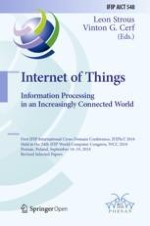
Open Access 2019 | OriginalPaper | Buchkapitel
Internet of Things: The Present Status, Future Impacts and Challenges in Nigerian Agriculture
verfasst von : Funmilayo O. Bamigboye, Emmanuel O. Ademola
Erschienen in: Internet of Things. Information Processing in an Increasingly Connected World
Aktivieren Sie unsere intelligente Suche, um passende Fachinhalte oder Patente zu finden.
Wählen Sie Textabschnitte aus um mit Künstlicher Intelligenz passenden Patente zu finden. powered by
Markieren Sie Textabschnitte, um KI-gestützt weitere passende Inhalte zu finden. powered by